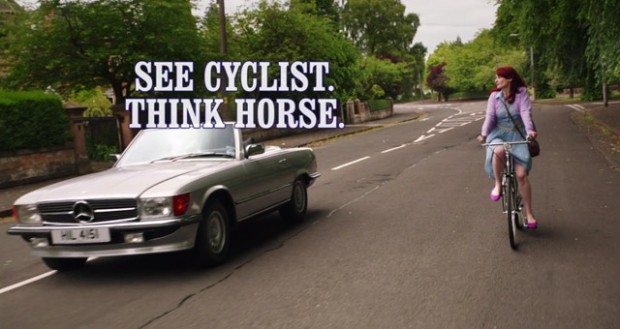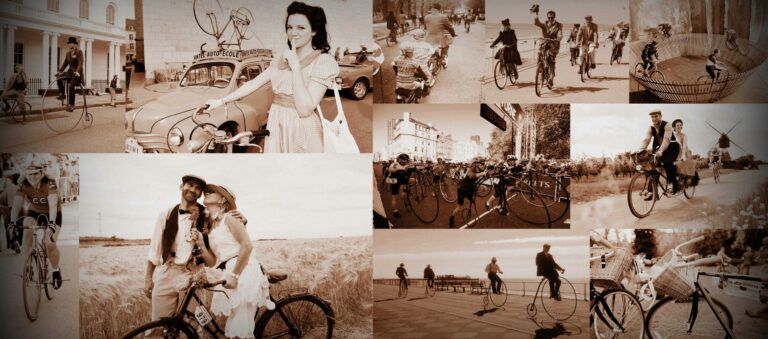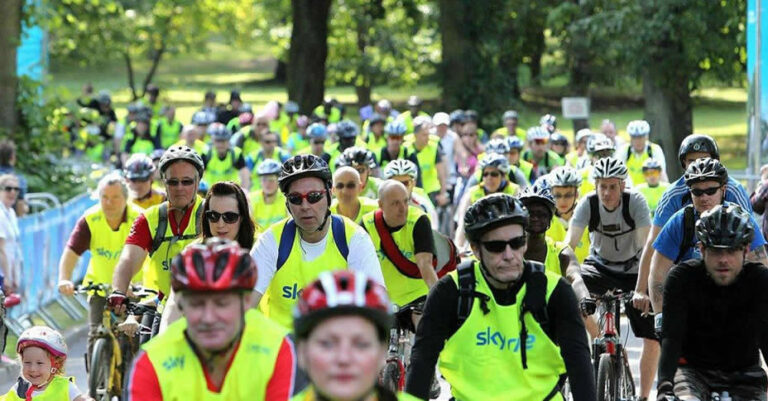A road safety advertisement by Cycling Scotland has inadvertently triggered a row between the Advertising Standards Authority, and several cycling campaign groups.

“See cyclist, think horse” was the message of advert produced by Cycling Scotland to highlight to drivers how to overtake cyclists safely on the road.
Featuring a montage of amusing cyclists-as-horses clips, it ended with the simple message that drivers should ‘Slow down, treat them with care, and give them their space on the road’ accompanied by a clip of a happy driver safely overtaking a happy cyclist.
And this is where the ‘problem’ arose. The ASA received and upheld a number of complaints about two elements of the advert. Namely that the cyclist was not wearing a helmet, and that she was riding too far from the kerb.
Cycling Scotland responded immediately, pointing out that the wearing of helmets is not compulsory under the highway code, and that it is also recommended that cyclists should in fact position themselves in either the primary or secondary positions in the road.
Highway code and helmets – rule 59
- Clothing. You should wear; a cycle helmet which conforms to current regulations, is the correct size and securely fastened.
Road Positioning
- According to the Bikeability cycle training, which is based on the National Standards for cycle training set for the Department for Transport, cyclists should be riding in one of two positions.
- Primary position: In the general flow of traffic, usually the centre of the lane. Also known as ‘taking the lane’. Example of use: when travelling at the same speed as the surrounding traffic.
- Secondary position: To the side of the road, not less than 0.5m from the kerb, and roughly 1m to the left of traffic flow.
- [Taken from Bitesized Bikability on the British Cycling website.]
The ASA withdrew the ban pending an independent investigation, admitting that they may have made an error with regard to the second point. However, they also stated that since the highway code did recommend the use of helmets, advertisements with cyclists should have them wearing them.
This is where national cycling charity CTC jumped in, in support of the suggestion that the ASA were overstepping their remit somewhat. In particular, they’ve said that:
“The ASA’s ill-advised decision shows a misunderstanding of common cycle safety issues and risks undermining the promotion of cycling and risks undermining the promotion of cycling as a safe and normal activity”
Gordon Seabright, CTC Chief Executive
They’ve started a petition at change.org to have the ASA ruling fully overturned, which you can read about and sign here if you’re feeling so inclined.
CTC have also decided to highlight the apparent contradictions in the original ruling by highlighting other adverts that do not conform exactly to the highway code, and are asking members of the public to send in examples.
As an example of the above – remember that Boots christmas ad that saw a hooded youth running around on a dark winters evening delivering presents? Well, according to the highway code pedestrians should ‘use reflective materials (e.g. armbands, sashes, waistcoats, jacket, footwear)’ when it is dark.
We at Total Women’s Cycling are also sad that the original message of what was, we thought, an unusual and light-hearted way to inform and educate has been lost in the row that ensued.
The discussion continues, and we wait to see what the outcome is.
Liked this? You will also love:
Twitter Trend: #ReplaceBikeWithCarCycle
Groundbreaking Safety Technology Trials on London Buses to Start this





